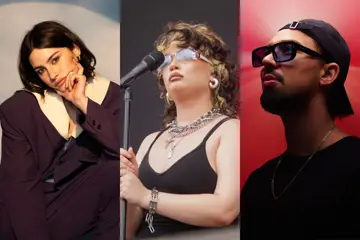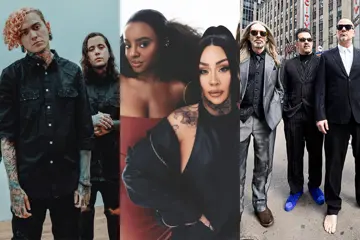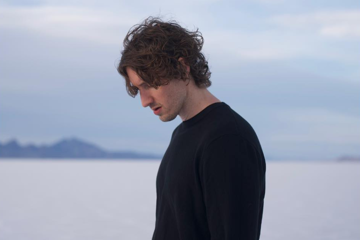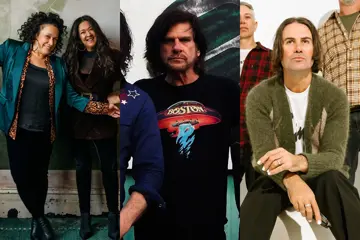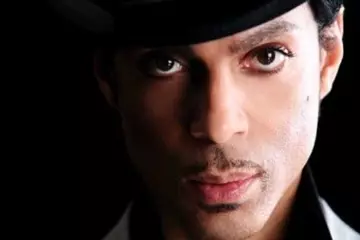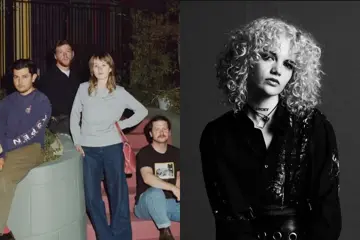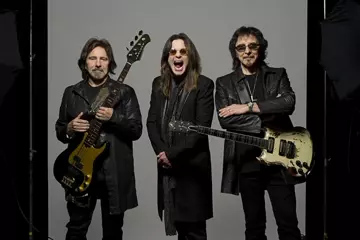If you know who Peter Green is, you’re strangely not the target audience of Amazon Prime Video’s shiny but unhopeful new streaming series Daisy Jones & The Six.
Forgetting for a second the sheer, rarefied cache of claiming a close-up sighting of the full Fleetwood Mac lineup in their natural habitat, if it wasn’t clear to you why the mere mention of Green’s presence at their 1998 Hall of Fame induction was reason itself to solicit a standing ovation, you’re even less a target of this series and have no place calling yourself part of Gen Wired and Tired.
Anyone who survived the 70s would be roughly listed in the character notes as VINYL ENTHUSIAST BORN B.C. (1980) / A.(CD). But incomprehensibly, it’s the very Sunset Strip natives it claims to represent who the series not only alienates, Statler & Waldorf style but seats front row in their own worst nightmare. Lindsay Buckingham as Jake from Melrose Place? Is this fable or a farce?
Fleetwood Mac loyalist Taylor Jenkins Reid wrote the fizzling lemon pop paperback upon which the show was based. Custom written for circa ‘77 Sunset Strip tragics and fresh-breed songwriting neuroscientists, the book failed to fool anyone entirely, but it seems nothing can stop the young and restless from picking up and taking a cursory glance through a fictional songbook bound by the blind lunacy of the great American rock myth.
Don't miss a beat with our FREE daily newsletter
The series, all trivial style with no recognisable substance, rides the tide of the zeitgeist only to crash dazedly upon the shores of mediocrity. Not even Daisy’s nightingale eyes, Bukowski-esque lyricism and winged stage cape can rescue this minor travesty from the uncomfortable silence it contributes to post-Warhol music mania.
The show’s self-proclaimed status as 2023’s most hotly anticipated serial retrospective (confident much?) is proven suss within 5 minutes. Particularly since it was brought to the small screen under the close supervision of its own best-selling author. But details schmetails.
Reid never tried to hide the fact that the titular lead character and co-singer / songwriter in The Six is just a young Stevie Nicks, (very) flimsily disguised by a walking cardboard cut out of a troubled valley girl.
Like Chrissie Hynde, don’t get me wrong. It tries hard. But perhaps that’s the problem, given the era was all about trying not to. As a rough salute to history’s most deftly defiant soft rock pioneers, not only does the series not get there, it tips so far into not-getting-their-land that it practically makes it to Alabama. A walkout is practically demanded. You simply have to see this shit.
Beyond the haircuts - and I’ll get to those in a minute - the show’s characterisation or re-telling of a halcyon era best left translated by its originators is vague at best, facile and empty at worst.
They get the guitars right. Any Fleetwood Mac nut with half a magnifying glass would give them that. And who doesn’t want to be transported to a world where lines like “This is just temporary. When my album comes out, I’mma buy a house in the Hills. *Pause.* Double-storey,” roll off the tongue like tally-hos?
Pity the acting is like watching a masterclass on how to act like ornamental wormwood.
Surprisingly, Riley Keough, a darling of the indie world and usually pretty good even struggles to not look like she’s rehearsing on the first day of Year 9 acting class at Brentwood High in some scenes. Particularly when she walks.
Maybe she’s method.
Super-sized production values and under-scored details is where things go wrong. Eye spy a backstage party with something beginning with OVERDONE ERA-SPECIFIC COSTUMING AS METAPHOR FOR THE MOST DREADFULLY DISGUISED EXPOSITION IN SCREENWRITING HISTORY. See the final scene of episode one in which our erstwhile wet-haired antihero nails her first-ever piano ballad.
Accompanied by the obscene audio backing of a spontaneous orchestra which, in terms of historic accuracy, belongs more to late 80s Elton or mid-20s Adele than it does an era made definitive by Kristofferson in A (Soon To Be Dead) Star Is Born, we bare audience witness to Daisy at the very moment she falls upon a songwriting self and finds her (sorry, I can’t say it and you can’t make me) …
The original score and soundtrack to support the narrative has made a promising start at this point, despite the script’s propensity to chuck the best work of its actors under the bus each time they approach sympathy. And we love the refined oak, Carole King naturalism Keough effortlessly references as the only cast member whose hair isn’t made of polyester or polyamide, depending on which angle you look.
But in her character’s pre-Tusk moment, as she shakes off the Band-Aid snakeskin and tenuously crosses the High St intersection of female muse over to budding fellow musician “on Sunset,” Keough’s Daisy may be as floral and fecund as our Stevie but carries off none of her androgynous, Arizona bred goddess power, despite valiant attempts to downplay the caricature and give it a chance.
Nevertheless, we watch on as she primes herself to face off with the show’s version of Lindsay and his assigned band sibling step-ins, only to have our aristocratic tyres flattened by the godawful obviousness of King’s I Feel The Earth Move, playing over a newly awakened Daisy slow-motion strutting toward rolling credits. Hashtag are they serious RN?
Like the show itself, the overpaid and over-informed costume designers come close and try mighty hard, but in their strain to go all Linda McCartney on us, the ensemble ends up coming off more like the Village People at a teenage dress-up party.
Really though? Really? Do they even manufacture sunglasses that big? And even if they did, can they at least fit them evenly on the heads of the moustache-club extras before they go telling everyone they’re cool and expecting us to believe it? Neatly pressed factory-distressed denim has no place in 1975 for absolute starters. It’s pale blue, badly engineered, un-ironed mom jeans or why bother?
Daisy (what sort of Stevie-loving name is that anyway?) Jones as a blossoming, tough-lipped ingenue surrounded by a Fleetwood Mac-shaped lineup of male musicians is about as far as it gets in terms of cultural accuracy. And we’re not talking pop here; let’s not forget.
Bottom line is, if you’re gonna pay such epic homage to an era of music that not only defines America’s most notoriously lofty counterculture movement but is set in an LA location that only medical-grade The Doors aficionados from Greenwich would be able to fully explain, you’re gonna wanna get it right.
The story’s archetypal mentor slot is filled by a Donna Summer-style stand-in, played with Nina Simone-sized aplomb by Nabiyah Be. As an experienced player on the nascent scene, she offers an affectionate attempt at being influential despite her own middleweight beginnings. Miss Jackson meddles as Miss Jones muses and we want to see more of this.
Reid’s originating novel with its prosaic passages went some ways to relieve a worryingly cliched subject matter of one-dimensionalism, giving the great, decade-spanning rock myth room to breathe by sheer virtue of its long-form format. Even as a work of fiction, the paradoxically less popular but more accurate book is a re-issued b-side equivalent to the brassy, made-for-streaming, instal-entrepreneur-age adaptation.
Those like me born after 1976 could go either way. At Ep 2 of 10, I’m yet to be swayed to the millennial side.
At a generous stretch, the book is the Bare Trees long player to the Tango In The Night box series.
And if you don’t know exactly where Bare Trees sits in the sweeping pantheon of Fleetwood Mac’s genre and gender-defying history, you’re either not trying hard enough or shouldn’t be watching the show on principle. Full disclosure: I land on the latter side of the two storied histories and refuse to binge-watch streaming series on principle anymore, so I’ve only seen episode one (Quell horreur! An entire essay based on anything less than 18 hours of back-to-back telly? What? Yeah.) But to be fair, I’d struggle to recognise a Bare Trees track it came at me in a Big W elevator.
So why am I still talking?
Perhaps this is the latent genius of showrunners Neustadter and Graham’s Hollywood-generated digital pantomime.
Incredulity as a conversation starter. The sheer wrongness of it all. Viewer-inclusive blood, sweat and bile starting with “back in my day…” and ending on the back of a bad cast - a cast equalised, but only just - by the immaculate assignment of Keough as Daisy. She owes it to her generation, who owe it to her granddaddy.
Spot her in some scenes strapped with her inheritance of Elvis’ withered, 100% non-phoney, floral-emblemed, straight-from-the-storeroom-at-Graceland and soaked-in-Sinatra’s-aftershave (see Ed Sullivan) guitar strap.
Further full disclosure: I might have made the name of the show up, but is anyone honestly watching close enough to really care here? And it’s the 70s/early 80’s now. Musicians no longer bother themselves with being wistful about the past. They’re too busy being it if this show is anything to go by.
Ladies and gentlemen. We’ve got the threads. We’ve got the Les Pauls. The ubiquitous hashish? Don’t stop us now. We’ve got the model girlfriends and the Roxy Theatre. We’ve even got some of the backstage details semi-accurate when we take you to that eponymous The Doors show you all know and love. Come. On. Down.
Daisy Jones & The Six boasts all the right era-specific intonations without the inconvenience of genuine intrigue or principle.
It’s counterculture-approved, unauthorised outré, rebranded and repackaged for the post-post-millennial, post-YouTube, post-streaming generation. Oh and ain’t the kids just all about that little cashew right about now? It’s rebrand or die. Regram or regret. Plug in and tune out. And yet, somehow beautifully, they have the audacity to buzz it woke.
This gregarious spectacle of rock rule book breaking… This shining exemplar of exactly why there’s ill-advised filmmaking and then there’s just a whole new level of plain stupid - was (also somehow beautifully) brought to you by - get this - Hello Sunshine’s Reese Witherspoon, the most Boomer Gen Xer since Mary Tyler Moore. Sorry Mary. That was way mean. I love that woman.
But come ON Reese. Come. On. For a woman who played June Carter in a film about Johnny Cash, she simply should know better. And if Stevie Nicks had anything to do with it, shame on Stevie.
But I digress.
As a conversation starter, it’s the water cooler series of the season. With plot dimensions tricky enough to distract you just long enough to get away with the bold but bothersome attempt.
So why again can no one stop talking about Daisy Jones & The Six?
There’s a scene presumably lifted directly from the book, where Daisy Jones makes her well-rehearsed debut as a regular on the scene at the Whisky a Go Go - at least to those of us on the sofa and not guardian in the making Simone Jackson who reckons she’s seen her around for years. A swirling montage that’s more Austin Powers than it is Oliver Stone promises intimate, simultaneous insight into Daisy’s layered emotional landscape and her specific musical taste as a budding musicologist (or a musician and/or fan, but who can tell, it’s the 70s).
Just as we’re starting to trust her. Just as she’s becoming more to us than the pretty granddaughter of RnR ™ royalty. Just as we glimpse Jim Morrison’s brickish chin and a thousand matching white skivvies that, just by the way, are far too perfectly bleached to belong anywhere near the 70s, she clocks the band and drifts into miasmic longing. Now, I ask you. Which band do we see next. You’ll notice there was no question mark there. This is not a rhetorical situation we’re dealing with.
Yes, which did the show choose to encapsulate this pivotal moment in the protagonist’s journey? Out of all the pioneering, Sunset Strip west coast cocaine bands available for the part.
The Byrds.
Ladies and gentlemen. The Byrds.
I rest my case.
OH I KNOW, I KNOW. WHO DOESN’T LOVE THE BYRDS? But let’s face it, it’s only because enough time has passed to fully forget.
Viewer discretion, or watching through hands half closed, depending on which side of history’s music fence you shake your tambourine on is strongly advised. Don’t wait ’til you’re ready of course, do it like the kids do. Finish a series about yesterday, yesterday. (Sorry Mr McCartney).
It’s Binge Watch a Go Go. #hashtag.
And no one has to even clean up the spew.

DISCLAIMER: The journalist wishes to clarify that the guitar strap in question was from the Elvis '68 Comeback Special.

